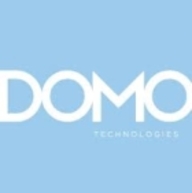

Tableau and Domo are prominent competitors in the business intelligence and data visualization market. Tableau tends to have the advantage in visualization capabilities and user-friendliness, while Domo excels in data integration and rapid deployment scenarios.
Features: Tableau offers strong drag-and-drop functionality, geo-spatial analysis, and data blending capabilities that facilitate self-service analytics without coding. Its connectivity to various data sources and community support also enhance its flexibility. Domo, meanwhile, excels in data integration with its Magic ETL tool and its collection of preconfigured apps, which simplify the deployment process.
Room for Improvement: Tableau can expand its advanced data science capabilities and improve handling of large datasets and dynamic parameters. In contrast, Domo could enhance its visualization options and support for large data processing while improving integration with advanced analytics and machine learning tools.
Ease of Deployment and Customer Service: Tableau offers On-premises, Public Cloud, and Hybrid Cloud deployment options and is praised for its high-quality customer service and strong community support. Domo presents strong Private and Public Cloud deployment features with good customer support, though it may require more attention to complex service requests, particularly where data integration tasks are substantial.
Pricing and ROI: Tableau's pricing is often seen as higher compared to products like Power BI, yet it is considered cost-effective for larger deployments due to its comprehensive feature set. Domo's pricing reflects its capabilities as an all-in-one platform for data integration and analytics, offering a favorable ROI by quickly deriving insights from large datasets despite the higher cost. Both products are seen to offset costs over time due to their efficiency and the time savings they deliver.
This saves a significant amount of time, particularly for reports that would have needed around fifty people.
The ROI of using Tableau extends to its seamless integration across various platforms, as it's from Salesforce and thus not limited to any specific cloud provider.
Tableau is saving me time, money, and resources, which I would rate as ten.
While they eventually provide the correct answers, their support for smaller customers could be improved.
They provide quick email and phone responses and have Thai-speaking personnel.
There should be consistent standards for all users.
The technical support for Tableau is quite good.
Sigma, which is written for Snowflake, scales more easily than Domo.
Tableau is easy to use across various dimensions, whether on-premises or on the cloud.
The solution is fully scalable and performs well even with large datasets, provided there is proper supporting hardware.
Tableau is easy to scale.
The application hangs after continuous use due to the buildup of cache.
I rate the stability a five or six because Tableau updates very often with new versions or patches.
End users require a license to run their own reports and dashboards, which are fairly expensive.
We cannot send the entire Excel file reports via email within Tableau.
The product owner should enhance its benefits or clarify its role.
It sometimes requires extensive investigation to determine why the data does not appear correctly.
Domo is expensive compared to other solutions.
Power BI as a much cheaper alternative.
A license for 150 users costs around $17,000 USD per year.
Looker is known to be quite expensive.
I have been using it for four years and have been able to extract the information I need from it.
A significant feature for me is the real-time connection to data sources because it effectively manages large data sets.
Tableau serves as a stable dashboarding tool for higher management, aiding in quick decision-making.
Building hyper extracts and visualization capabilities make Tableau a robust tool for data analysis.




Domo is a cloud-based, mobile-first BI platform that helps companies drive more value from their data by helping organizations better integrate, interpret and use data to drive timely decision making and action across the business. The Domo platform enhances existing data warehouse and BI tools and allows users to build custom apps, automate data pipelines, and make data science accessible for anyone through automated insights that can be shared with internal or external stakeholders.
Find more information on The Business Cloud Here.
Tableau is a tool for data visualization and business intelligence that allows businesses to report insights through easy-to-use, customizable visualizations and dashboards. Tableau makes it exceedingly simple for its customers to organize, manage, visualize, and comprehend data. It enables users to dig deep into the data so that they can see patterns and gain meaningful insights.
Make data-driven decisions with confidence thanks to Tableau’s assistance in providing faster answers to queries, solving harder problems more easily, and offering new insights more frequently. Tableau integrates directly to hundreds of data sources, both in the cloud and on premises, making it simpler to begin research. People of various skill levels can quickly find actionable information using Tableau’s natural language queries, interactive dashboards, and drag-and-drop capabilities. By quickly creating strong calculations, adding trend lines to examine statistical summaries, or clustering data to identify relationships, users can ask more in-depth inquiries.
Tableau has many valuable key features:
Tableau stands out among its competitors for a number of reasons. Some of these include its fast data access, easy creation of visualizations, and its stability. PeerSpot users take note of the advantages of these features in their reviews:
Romil S., Deputy General Manager of IT at Nayara Energy, notes, "Its visualizations are good, and its features make the development process a little less time-consuming. It has an in-memory extract feature that allows us to extract data and keep it on the server, and then our users can use it quickly.
Ariful M., Consulting Practice Partner of Data, Analytics & AI at FH, writes, “Tableau is very flexible and easy to learn. It has drag-and-drop function analytics, and its design is very good.”
We monitor all BI (Business Intelligence) Tools reviews to prevent fraudulent reviews and keep review quality high. We do not post reviews by company employees or direct competitors. We validate each review for authenticity via cross-reference with LinkedIn, and personal follow-up with the reviewer when necessary.